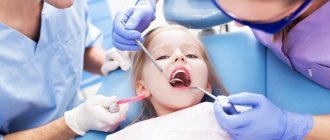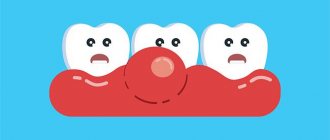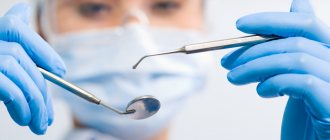Pediatric dentistry can be considered a separate section of modern dental practice, because due to the structural features, the treatment of baby teeth is somewhat different from the treatment of permanent teeth. Unfortunately, many parents are still convinced that baby teeth do not need dental care - after all, they will soon break down and fall out anyway. Therefore, children are not taken to the dentist very often, and if they are taken to the doctor, it is with advanced diseases and multiple problems.
In fact, dental treatment should be carried out at any age, and the sooner you consult a doctor with a problem, the higher the likelihood of getting rid of it quickly and without any complications. If a child has bad baby teeth, this will inevitably affect the health of his permanent ones - this is what parents need to remember when they want to “pity” the baby and not take him to an appointment with the “evil dentist.”
Why does caries occur in childhood?
It is known that caries is a pathological process that occurs in the hard tissues of teeth under the influence of internal and external factors. Carious lesions arise as a result of the “work” of cariogenic bacteria living in the oral cavity.
In this article
- Why does caries occur in childhood?
- Features of caries of milk teeth
- Symptoms of carious lesions in baby teeth
- Why is caries treated for young children?
- How is caries treated in children?
- Methods for treating childhood caries without drilling
- Invasive treatment of caries
- Do they give anesthesia to children?
- Prevention of childhood caries of primary teeth
By processing carbohydrates that enter the mouth with food, these bacteria produce acid. It is this that contributes to the destruction of enamel, dentin and other tooth tissues. Several factors contribute to the proliferation and active activity of cariogenic bacteria, which ultimately leads to the development of caries in children.
- Improper dental hygiene.
Insufficient cleaning from plaque, infrequent cleaning.
- Eating high in carbohydrates.
Children who eat a lot of sweets and flour, drink sweet compotes at night, and snack on chocolates are more susceptible to developing caries. A favorable breeding ground for microbes is formed in their mouth.
- Reduced immunity.
Weakened immune defense does not allow the body to effectively resist negative influences, so children with weak immunity develop caries more often.
- Features of intrauterine development.
The formation of teeth occurs in the first trimester of pregnancy, and it can be affected by the lifestyle, health, and previous diseases of the expectant mother.
These factors contribute to the fact that tooth enamel begins to lose mineral substances, cariogenic microbes multiply in the mouth, and as a result, dental caries develops.
How is the progression of pulpitis in permanent teeth different in children?
Pulpitis is a serious disease, it must be treated, otherwise you can actually lose a tooth, get gumboil and even blood poisoning.
As in other age groups, pulpitis in adolescents under 14 years of age occurs in 2 main forms:
- Acute, with severe pain at night and in the evening, a painful reaction to temperature and chemical stimuli, an increase in temperature in case of general intoxication and the development of purulent complications.
In the absence of timely adequate treatment, the acute form becomes chronic.
- Chronic. This form of pulpitis can pass painlessly with the appearance of periodic pain reactions to cold, hot, sour, sweet. The acute inflammatory process in the pulp subsides, and the sluggish course of the disease contributes to the development of complications from periodontal tissues. Exacerbations occur periodically.
Attention parents! During adolescence, children may hide the disease and take painkillers uncontrollably.
Features of caries of milk teeth
Saliva at an early age does not have sufficient antiseptic properties, and microbes easily multiply in the oral cavity. At the same time, the degree of enamel mineralization in baby teeth is less than in permanent teeth. In this regard, childhood caries spreads very quickly. If in an adult a carious lesion on permanent teeth can develop from an early stage to a deep one over several years, then in children the same process takes only a few months.
In a child, dental caries often affects several teeth at once. Only children have such types of caries as ring-shaped and planar. The condition of the dental system is also affected by various infectious diseases to which children are susceptible.
How to choose a doctor for your child
A child's first visit to the dentist is a very important event that should be taken very seriously. It is imperative to find a doctor who gets along well with children and to whom the child will go with great pleasure. This will determine whether he will have a fear of dentists in the future.
It is recommended that you spare no expense for the first time and take your child to a paid clinic . In such institutions, treatment is accompanied by a friendly attitude from the staff; children are often shown cartoons and given toys to play with.
Symptoms of carious lesions in baby teeth
The manifestations of caries depend on what stage the process is at.
For early caries (the so-called stain stage), a characteristic sign is a light spot or thin line on the surface of the tooth enamel. This is an area of demineralization - the focus of carious lesions. At this stage, it is difficult to notice caries without the help of a dentist, because the child does not show anxiety or complain of pain or discomfort.
When the process enters the superficial stage, a dark pigmented spot forms on the tooth enamel, which has a rough structure. The tooth may react to sweets, and during the examination the doctor discovers areas of softening of the enamel.
At the next stage of middle caries, dentin is damaged - the bone tissue of the tooth, in which a cavity is formed. The lesion looks like a darkened area, food gets stuck in the hole, and the child complains of pain when eating cold or hot food.
At the stage of deep caries, it is painful for the child to chew, the tooth reacts to any irritants, it can hurt on its own, and partial or complete destruction of the crown occurs. A characteristic type of childhood caries is the bottle form. It affects the dental neck and occurs in infants who often feed from a bottle for a long time. Depending on the form, stage of the disease, and the age of the child, the dentist will decide how to treat teeth affected by caries.
At what age can teeth be treated with sedation?
Most often, teeth can be treated under sedation starting from the age of 3 - it is from this age that the child can already contact the doctor, understand what he wants, and fulfill his requests.
Up to 3 years, if long-term extensive treatment is necessary, anesthesia is used. The duration of treatment under sedation depends on the dental treatment, but can be up to 1 hour.
This is due to the effect of the anesthetic, which the doctor administers before starting treatment, and the fact that it is difficult for the child to sit in one uncomfortable position for more than 1 hour. During this time, you can treat 2-3 teeth in one area of the dentition. When using sedation, an individual approach is required - the doctor focuses on the patient, his condition, and the duration of dental procedures.
Why is caries treated for young children?
There is a myth that baby teeth with caries do not need to be treated, as they will fall out anyway. In fact, dentists unanimously say that treatment of childhood caries at any age, both on milk and permanent teeth, is mandatory.
There are several reasons why caries of baby teeth should be treated before the age of 5-6:
- The baby tooth preserves space for the permanent tooth and stimulates its growth.
- It takes part in the chewing function and, therefore, in the digestion process.
- Baby teeth affected by caries are a source of chronic infection in the child’s body. In addition, the root of the baby tooth is located next to the germ of the permanent tooth. If caries in children is not treated, the inflammatory process can affect permanent teeth even before they erupt.
- Healthy baby teeth are necessary for a child to develop high-quality speech skills and correct pronunciation of sounds.
- If parents do not treat their child's caries, this can lead to untimely loss of baby teeth. Because of this, other teeth in the row shift, permanent teeth begin to cut in the wrong place, which leads to malocclusion.
- Early loss of a baby tooth can delay the eruption of a permanent one.
This is why it is so important to preserve baby teeth until they fall out naturally. And this can only be done if baby teeth are treated properly in a timely manner.
Dental treatment under anesthesia
In most cases, treatment is carried out after the introduction of anesthesia, which is divided into two types - application with local application of medication and injection, which involves the administration of an injection. The second option is safer and more effective.
If a child has panic fear or is simply restless, anesthesia is used, but before using it, a number of diagnostic measures are prescribed:
- biochemical blood test;
- general blood and urine tests;
- blood to determine sugar levels;
- electrocardiography to assess the state of the heart.
You should not eat food 5–6 hours before anesthesia, and drink water and other liquids 4 hours before.
Sleep is induced very gradually using sevoflurane-based gas. If the child needs to be woken up, the doctor increases the amount of oxygen supplied, and this can be done at any time. After waking up, all reflex functions are fully restored within the first 15 minutes. As a rule, there are no complications.
How is caries treated in children?
What to do if a child has caries? Parents often ask dentists this question. And the answer is to treat. It is not so important when a child develops caries, whether he is one year old, 5 years old or 12 years old; dental disease is treated at any age. The only difference is how exactly dental caries are treated.
Different treatment methods are divided into two main groups - conservative and surgical. Conservative ones allow you to quickly and painlessly stop the carious process without drilling the tooth. Such techniques are most suitable for children, but they are effective only in the early stages of caries.
Surgical treatment involves drilling the carious cavity with a drill, removing the affected tissue and installing a filling. In case of deep or moderate caries, it will not be possible to cure a tooth without preparation.
Is it possible to cure caries in a child without drilling? What methods are there?
It is possible if the carious cavity is at the initial stage.
- Remineralizing therapy.
- Treatment method with the Icon system.
- In some cases, we replace the drill with a RONDOflex device - this is an air-abrasive handpiece. Preparation occurs using a mixture of water jet and aluminum oxide powder. The treatment proceeds in a gentle manner and is not accompanied by noise, vibration, or unpleasant sensations.
Unfortunately, most often parents bring their child to the clinic when a tooth is already bothering him and the baby complains of discomfort or pain. Usually this is already the stage of pulpitis. In these cases, treatment without a drill is impossible.
IMPORTANT! I always recommend my patients to come for a preventive examination 2 times a year, even if there are no complaints. Often pathological processes in the tooth are asymptomatic.
Methods for treating childhood caries without drilling
A child has been diagnosed with a carious spot, that is, initial caries - what to do in such a situation. The doctor may offer several options.
- Fluoridation.
A special composition with a high concentration of fluoride is applied to the surface of the tooth enamel. The mineral substance helps strengthen the enamel, restore its structure, and helps stop the further process of tissue destruction.
- Remineralizing therapy.
The teeth are coated with compounds containing phosphorus, calcium, magnesium and other minerals. The treatment promotes the remineralization of enamel, restoring its strength and structural characteristics.
- Ozone therapy.
Another modern non-invasive method in which children's teeth are treated with ozone. It destroys different types of cariogenic bacteria, preventing their proliferation in the oral cavity.
- Silvering.
Previously, this method was very popular, today it is used less frequently due to the fact that it affects the aesthetics of the teeth. After silvering, white baby teeth acquire a distinct dark color. The essence of the method is that tooth enamel is coated with compounds containing silver. They have an antiseptic and bactericidal effect, forming a protective film on the surface that prevents the spread of infection. Silvering does not cure caries, but it helps slow down the process of tooth decay.
Invasive treatment of caries
If there is a hole in a tooth, it is treated as if it were permanent, using an invasive method. First, using a drill, the dentist prepares the carious cavity and removes softened, pigmented tissue. Rinses, dries and disinfects the tooth.
After sanitation, a filling is placed inside the cleaned cavity. Today, light-curing filling composites are the most popular. They are applied in layers, and at each stage they are illuminated with a special lamp for curing. Light-curing fillings have good strength, long service life and do not shrink, which reduces the risk of developing recurrent caries under the filling.
After installing the filling, the doctor adjusts it to the bite, grinds and polishes it, giving it the correct anatomical contours.
Do they give anesthesia to children?
Many parents are concerned about how to painlessly treat teeth in children under 5 years old.
Non-invasive methods are absolutely painless. If a cavity needs to be prepared, anesthesia may be required. Children most often undergo two-stage anesthesia. First, the gum area is treated with an anesthetic gel, which numbs the injection site, and then an anesthetic injection is given.
In some cases, it is advisable to use sedation - when the child is introduced into a relaxed state of half-asleep using a special gas. Choosing the optimal method of pain relief and treatment is the responsibility of the dentist.
Prevention of childhood caries of primary teeth
Caries of primary teeth can be prevented if you listen to the recommendations of dentists and follow preventive measures for this dental disease.
- Take care of your oral cavity from the moment the first tooth appears.
Previously, it was believed that young children needed to brush their teeth from about one year old, when they grew eight front incisors. Modern dentistry has revised this approach, and today it is recommended to brush children’s teeth as soon as the first baby tooth has erupted. This usually occurs between 6-9 months of age. It is clear that a baby cannot take care of the oral cavity on his own, so this task falls on the shoulders of the parents. The first teeth are cleaned with special fingertips or a baby brush without toothpaste. The brush should have a small cleaning head and ultra-soft bristles. As they approach the age of one year, they begin to brush their teeth with fluoride-free toothpaste. As the child gets older, the size of the head and the stiffness of the bristles may change. For example, for a child aged 5 years, you can purchase a toothbrush with medium-hard bristles.
- Follow the rules for brushing your teeth.
A child may develop caries even with regular brushing if this process is left to chance. Children under about 7 years old cannot brush their teeth properly, so parents should help them and monitor the process. Proper oral care involves brushing your teeth twice - in the morning after breakfast and in the evening before bed. The hygiene procedure should not take less than 2-3 minutes. It is important to ensure that the child thoroughly cleans each tooth on both sides and cleans the chewing surfaces. A large number of bacteria accumulate on the tongue and the inside of the cheeks, so at the end of cleaning you need to teach your child to remove plaque from these surfaces.
- Routine visit to the dentist.
Few children like to treat tooth decay. Modern methods make it possible to do this quickly, painlessly and without drilling, but only if the disease is detected at an early stage. This is why it is so important to take your child to the dentist twice a year, even if the child has no complaints. The doctor will check the condition of your teeth and give recommendations for care. Regular visits accustom your child to visiting the dentist and help get rid of fear. In the future, such children sit in the dental chair without any problems and have their teeth treated.
Follow these preventive measures and you may not have to treat your child’s caries.
Opportunities of modern pediatric dentistry
Just recently, no one thought about the fact that a child’s teeth should be treated as painlessly as possible. Treatment for the baby should take place in a psychologically comfortable environment. That nothing bad will happen, he will cry and forget. This is why there are so many adults who are afraid of dentists. They go only when the teeth hurt so much that it is no longer possible to endure.
Now there are many specialized children's dental clinics that take into account the psychological and physiological characteristics of children. These dentists do not resemble hospitals. On the contrary, their interiors are decorated in a children's style. This creates a relaxing environment for kids. These clinics are staffed by dentists and paramedical personnel. They specialize in treating young patients and know their psychological characteristics. In these medical institutions, only modern, gentle methods of treating dental diseases are used, and modern anesthesia is used. If the baby is completely unable to withstand the treatment, it is carried out under anesthesia.











